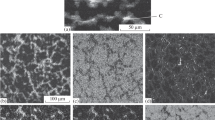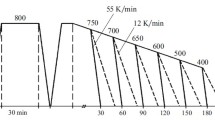Abstract
Specific features of the deformation characteristics of a Zn-Al-Cu alloy have been studied using nontraditional methods of plastic deformation, which enable low-temperature deformation to be implemented. When using a weak magnetic field and a direct electric current applied simultaneously, a strong macroplastic effect has been revealed upon active deformation of the alloy. In the absence of a magnetic field, the macroplastic effects have been considerably lower. A possible explanation of the observed effects has been offered.
Similar content being viewed by others
References
M. A. Aliev and A. R. Velikhanov, “Structure Reconstructions in a Many-Component Alloy with Self-Organization upon Plastic Deformation,” Poverkhnost, No. 12, 99–102 (2007).
V. I. Al’shits, E. V. Darinskaya, I. V. Gektina, and F. F. Lavrent’ev, “Study of the Magnetoplastic Effect in Zinc Single Crystals,” Kristallografiya 35(4), 1014–1016 (1990) [Sov. Phys. Crystallogr. 35, 597–599 (1990)].
V. I. Al’shits, E. V. Darinskaya, and E. A. Petrzhik, “Magnetoplastic Effect in Aluminum Single Crystals,” Fiz. Tverd. Tela 34(1), 155–158 (1992).
V. I. Al’shits, E. V. Darinskaya, E. Yu. Mikhina, and E. A. Petrzhik, “On the Nature of the Effect of Electric Current on the Magnetically Stimulated Microplasticity of Al Single Crystals,” Pis’ma Zh. Eksp. Teor. Fiz. 67(10), 788–793 (1998).
O. A. Troitskii and P. U. Kalymbetov, “Dependence of the Magnetoplastic Effect in Zinc on the Duration of Single Pulses,” Fiz. Met. Metalloved. 51(5), 1056–1059 (1981).
O. A. Troitskii, M. M. Moiseenko, and V. I. Spitsyn, “Influence of Series of Electrical Pulses on the Plastic Deformation of Metals,” Dokl. Akad. Nauk SSSR, No. 3, 587–590 (1984).
L. B. Zuev, “Electric Fields and Plasticity of Crystals,” Soros. Obraz. Zh., No. 9, 92–95 (1999).
A. I. Pinchook, “On the Nature of the Low-Field Electromagneto-Plastic Effect,” J. Appl. Phys. 92, 2343–2345 (2002).
N. A. Koneva, “Nature of Plastic Deformation Stage,” Soros. Obraz. Zh., No. 10, 96–101 (1996).
V. Ya. Kravchenko, “Influence of Electrons on Dislocation Drag in Metals,” Fiz. Tverd. Tela 8(3), 927–931 (1966) [Sov. Phys. Solid State 8, 740–744 (1966)].
A. A. Urusovskaya, V. I. Al’shchits, N. N. Bekkauer, and A. E. Smirnov, “Deformation of NaCl Crystals under Combined Action of Magnetic and Electric Fields,” Fiz. Tverd. Tela 42(2), 267–269 (2000) [Phys. Solid State 42 (2), 274–276 (2000)].
Author information
Authors and Affiliations
Additional information
Original Russian Text © A.R. Velikhanov, 2010, published in Fizika Metallov i Metallovedenie, 2010, Vol. 109, No. 6, pp. 690–693.
Rights and permissions
About this article
Cite this article
Velikhanov, A.R. On the effect of electric current and magnetic field on the physicomechanical properties of a Zn-Al-Cu alloy. Phys. Metals Metallogr. 109, 651–654 (2010). https://doi.org/10.1134/S0031918X10060128
Received:
Accepted:
Published:
Issue Date:
DOI: https://doi.org/10.1134/S0031918X10060128




